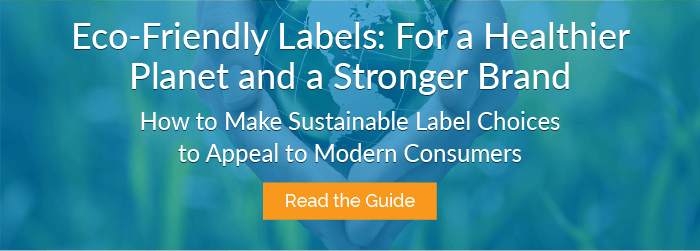
Eco-friendliness isn’t a nice-to-have anymore.
Today, manufacturers have an urgent responsibility (and are facing increasing consumer pressure) to reduce their environmental impact.
Fortunately, there are promising trends emerging, not just in sustainable labels and sustainable product packaging, but in how brands and regulatory bodies even approach the issue of sustainability.
Moving Beyond “Greenwashing”
The recent United Nations Climate Change Conference (COP26) was a reminder of our planet’s fragility and just how challenging it will be to implement real solutions to the many problems threatening our natural environment. When just two degrees of global temperature increase can lead to widespread disaster — as many experts predict — half measures and symbolic gestures simply won’t be sufficient.
The Glasgow conference is also a reminder that brands need to be wary of “greenwashing,” treating sustainability as more of a marketing stance than a legitimate effort to reduce your organization’s environmental impact. As we ponder our planet’s future, we must move beyond empty rhetoric on sustainability and toward genuine, holistic change.
(We should also point out that there are legal incentives to avoiding greenwashing. The California governor recently signed a law that strengthens regulations against claiming products or packaging are recyclable when they are not, and similar rules may follow nationwide.)
Product Labels and Your Brand’s Environmental Impact
So…where do your product labels come into play?
First, product labels and packaging are typically where brands make their sustainability claims, share recycling and reuse information, and encourage their customers to live sustainably. Labels have a role to play in nearly any corporate green initiative.
Second — and perhaps most importantly — the modern conception of true sustainability encompasses a product’s entire lifecycle, from raw materials to disposal. The ultimate goal is to create a circular economy where nothing is wasted and no new raw materials are extracted from the earth. (While this goal is admittedly lofty, reaching benchmarks along the way will still make a tangible difference.)
In this circular economy, every use of resources must be accounted for, including product labels and packaging. Currently, product packaging represents nearly 30% of total municipal solid waste in the United States!
Related Reading: Eco-Friendly Labels: Why Materials Matter
3 Sustainable Label and Package Design Trends
As it turns out, there are a few interesting changes taking place that show promise of bringing us closer to that circular economy. Here are a few sustainable package design trends we’ve observed lately:
1. The ‘Big Guys’ Take the Lead
When it comes to fully understanding the environmental impact of a product’s entire lifecycle, larger organizations have access to resources that smaller businesses lack.
Large companies can dedicate whole departments to conducting research and guiding their green initiatives. At most smaller businesses, “sustainability officer” is just one of many hats someone must wear.
If your company finds itself in this predicament, that’s OK. There’s no need to reinvent the wheel.
Several large corporations have undertaken major sustainability initiatives in recent years (which is a good thing!), so…learn from them. These companies likely have information on their websites and in their press appearances that can help you devise your own sustainability strategies.
Big companies are also driving change within the raw materials industry. A decade ago, the typical supplier would offer only three or four sustainable label materials. Nowadays, thanks to demand from large corporations, hundreds of eco-friendly label options are available.
2. Extended Producer Responsibility
Until recently, local governments (and by extension, residents) were expected to shoulder the cost of recycling or otherwise disposing of consumer products. Lately, however, the concept of extended producer responsibility has emerged. This theory suggests that manufacturers should pay for the end-of-life costs associated with their products, which would encourage manufacturers to design for greater sustainability.
It’s too soon to predict whether extended producer responsibility will take hold. But the idea’s existence is an indication that consumers and policymakers are not about to let companies off the hook for the environmental damage their products and product packaging may inflict.
3. Standardized Recycling Programs
Recycling options vary widely between regions. What’s recyclable in your area may not be elsewhere. And therefore, your brand may inadvertently commit greenwashing by claiming your product packaging is recyclable when most of your customers lack the appropriate facilities.
Several movements are underway to standardize recycling options across the U.S. and even around the world, but these initiatives are in their infancy. In the meantime, consider minimizing the need to recycle by making your product packaging reusable.
Related Reading: Sustainable Labeling: Moving Beyond Lip Service
Label Printing Recommendations for Brands Truly Committed to Sustainability
Sustainability is both a journey and a destination. More importantly, it’s a way of acting and thinking differently about how we’ve been using (and abusing) our planet and its resources, and how we can find smarter, more sustainable ways of doing things.
As far as sustainable labels are concerned, keep in mind that, like most manufactured products, labels are the result of a vast supply chain that sources raw materials from around the globe. It’s not just your environmental footprint that matters, but your label printer’s and their suppliers.’
The right eco-conscious label printer can help you make more sustainable decisions concerning label materials, ink and adhesive. Your printer can also help you weigh the benefits of particular options against their environmental costs, such as energy usage, shipping and packaging.
To help you start thinking about these issues (and avoid greenwashing your product labels), we’ve put together a complete (and free) Eco-Friendly Labeling Guide.
The guide includes an introduction to the circular economy, tips to help you reduce label and packaging waste, information about recycling labels and using recycled materials, and how to identify a sustainable label printer. Read the guide here.

